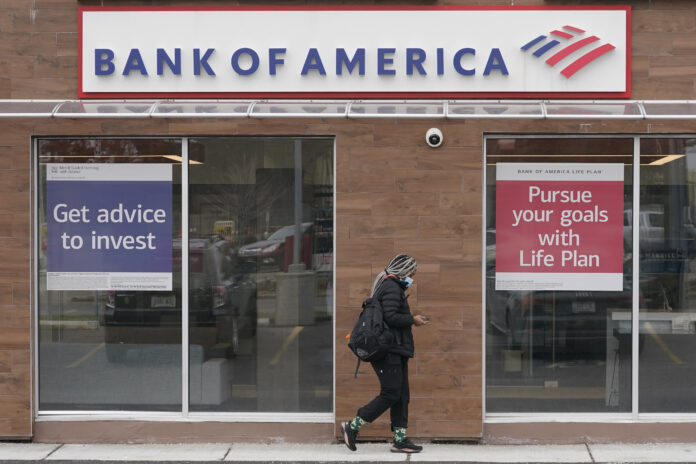
NEW YORK (AP) – Bank of America posted a 12% decline in first-quarter profits from a year earlier, a decline that was much less than the ones its rivals had reported the previous week. The nation’s second-largest bank was helped by higher net interest income and no noticeable exposure to Russian assets.
The Charlotte, North Carolina-based bank said it earned a profit of $7.1 billion, or 80 cents a share, compared with a profit of $8.05 billion, or 86 cents a share, in the same period a year earlier. The results were better than what analysts had forecasted, according to FactSet.
While BofA’s profits fell like the other big five Wall Street banks this quarter, their results were helped by a few factors that helped the bank do better than its rivals this quarter.
The bank saw net interest income increase 13% in the quarter, roughly $1.4 billion. BofA’s balance sheet is more skewed to bonds with shorter maturities, so short-term moves in interest rates tend to quickly impact the bank’s bottom line. Also a reflection of the rapid increase in interest rates, net interest margin, the difference between interest income generated and the amount it pays out – inched up 1 basis point to 1.69%.
The bank did not have to set aside much funds this quarter to cover potential losses as well, in contrast to JPMorgan Chase and Citigroup, who had to set aside money to cover the risk of a recession as well as for their exposures to Russia. The $30 million first-quarter credit loss provision still represented an increase over the first quarter of 2021, when the company released $1.9 billion from its loan loss reserves. The bank said its decision to build its reserve piles back up was due to “Russian exposure and loan growth.”
Like other banks, BofA saw a drop in investment banking revenues and fees in the quarter, which were cut by more than 35% to $1.5 billion, as businesses refrained from deal-making due to market volatility. Trading revenues were down in the quarter, also due to market volatility. These losses were partially offset by gains in lending service-related fees and those for investment and brokerage services, though non-interest income still declined 7.7% to $11.7 billion.
Non-interest expense of $15.3 billion represented a 1% decline over a year ago, including slight drops to compensation and benefits and occupancy and equipment costs.
Total quarterly assets rose 9.0% to $3.3 trillion, driven by a $90 billion increase in loans and leases. The $993.1 billion in loans and leases reflected strong commercial loan growth as well as an increase in consumer loans.
Quarterly deposits stood at $2.1 trillion, a 9.9% increase reflecting growth in demand and money market deposit accounts.
The North Carolina-based bank has 29 branches in Rhode Island and the second-highest share of in-state deposits as of June 30, 2021, according to the Federal Deposit Insurance Corp.
(Updated: Adds detail from SEC filing through out, includes reports from Providence Business News)











